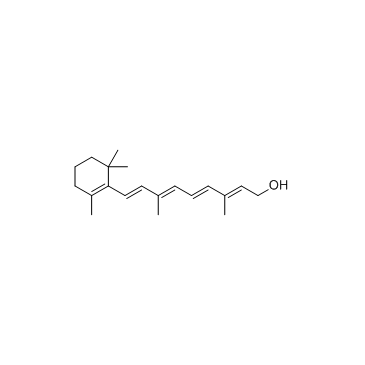Retinol (Vitamin A1) (Synonyms: all-trans Retinol, all-trans Vitamin A, NSC 122759, Vitamin A1 Alcohol) |
| Catalog No.GC31345 |
Retinol (Vitamin A1) is a fat-soluble vitamin in the vitamin A family that is found in food and used as a dietary supplement..
Products are for research use only. Not for human use. We do not sell to patients.

Cas No.: 68-26-8
Sample solution is provided at 25 µL, 10mM.
Retinol, also known as vitamin A1, is a fat-soluble vitamin in the vitamin A family that is found in food and used as a dietary supplement[1]. Retinol is typically measured in International Units (IU), with 1 IU of retinol equivalent to about 0.3 micrograms[2]. Retinol is transported in plasma, bound to specific transport proteins known as retinol-binding proteins (RBP)[3]. Also known as all-trans retinol, it primarily exerts its effects by activating retinoic acid receptors (RARs) and retinoid X receptors (RXRs), which are part of the nuclear receptor family, regulating gene expression and thereby affecting cell differentiation, proliferation, and death[4].
In vitro, retinol at concentrations of 0.1-3.5µM was added to human embryonic stem cell (hESC) culture media and continuously passaged. 2.0 µM of retinol promoted the proliferation of human embryonic stem cells and induced the expression of specific markers, indicating that retinol has the function of supporting stem cell self-renewal[5]. Retinol increased the expression of the NANOG gene, with its relative expression level increasing by 20 times in the presence of 2.0-3.5 µM retinol[5]. Additionally, retinol maintained the growth of undifferentiated cancer-like stem cells from mouse mammary tumors in long-term culture while eliminating non-CSCs[6]. In addition, 0.1% retinol can effectively treat skin photodamage, promote keratinocyte proliferation and epidermal thickening, thereby alleviating signs of skin aging[7].
References:
Low, J W, Arimond, et al.A food-based approach introducing orange-fleshed sweet potatoes increased vitamin A intake and serum retinol concentrations in young children in rural Mozambique.[J].Journal of Nutrition, 2007.
Shenai J .Vitamin A Supplementation in Very Low Birth Weight Neonates: Rationale and Evidence[J]. 2000.
[3] DeWitt,S,Goodman.PLASMA RETINOL-BINDING PROTEIN[J].Annals of the New York Academy of Sciences, 1980.
[4] Mangelsdorf D J , Umesono K , Kliewer S A ,et al.A direct repeat in the cellular retinol-binding protein type II gene confers differential regulation by RXR and RAR.[J].Cell, 1991, 66(3):555-61.
[5] Rajala K , Vaajasaari H , Suuronen R ,et al.Effects of the physiochemical culture environment on the stemness and pluripotency of human embryonic stem cells[J].Stem Cell Studies, 2011.
[6]Khillan J S .Vitamin A/Retinol and Maintenance of Pluripotency of Stem Cells[J]. Multidisciplinary Digital Publishing Institute, 2014.
[7]Tucker-Samaras S , Zedayko T , Cole C , et al. A stabilized 0.1% retinol facial moisturizer improves the appearance of photodamaged skin in an eight-week, double-blind, vehicle-controlled study[J]. Journal of Drugs in Dermatology, 2009, 8(10):932-936.
Average Rating: 5 (Based on Reviews and 35 reference(s) in Google Scholar.)
GLPBIO products are for RESEARCH USE ONLY. Please make sure your review or question is research based.
Required fields are marked with *




















